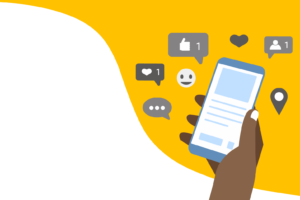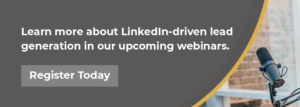5 Ways to Attract Better Prospects on LinkedIn

There are a lot of misconceptions about LinkedIn’s use cases as a sales and marketing tool. As a business leader, you may think LinkedIn is simply a place for job hunters, and your audience isn’t there. (They are…we’ll get to that!)
In reality, LinkedIn’s growth over the past few years hasn’t slowed down. According to recent site stats, over 830 million users are now on the platform.
More and more executives are now building their personal brands on LinkedIn, too. (Personal brands really are all the rage these days!) It can be a BIG missed opportunity for companies if their employees or execs don’t have personal brands online.
Our agency’s founder and CEO, Jackie Hermes, has used LinkedIn to grow Accelity to over 7 figures, with 27% of lifetime sales attributed to LinkedIn.
That said, are personal brands for everyone? The short answer is no. TBH, it’s easy to get bogged down in the details on how to start posting with…videos, interviews, graphics, *gasp* even selfies. But. it. works. LinkedIn can help your pipeline grow in many ways if you’re up for the challenge.
Pro tip: Combining your personal brand with LinkedIn Ads creates synergies that make your content viewed as credible, trustworthy and shareable.
Want to learn how to attract better prospects on LinkedIn? Check out these 5 tips:
1) Speak to your prospect’s pain points
Trying to appeal to everyone is a huge trap that companies fall into when they get started on LinkedIn. These companies think they’ll miss out on potential sales, but they actually miss out WAY more (when no one knows who your product or service is for).
Don’t overcomplicate it. Choose one audience to start with (not two or more) and address their pain points in your organic and paid content. Then ‘rinse and repeat’ when you perfect a formula for your target audience.
You can also use the targeted content you share on LinkedIn to drive traffic to your company website or your sales team.
2) …And make sure you relate to them on other levels
This isn’t a must, but it really makes you more personable when you talk about your everyday life and experiences. (Which is important because business is personal.) It’s fueled by people. And people connect with people, not just logos or brands–it’s the people who make up the brand that make the sale.
LinkedIn is used to connect human beings, not work robots. Creating a range of content means you are relating to others both personally and professionally on your platform.
How could talking about so much personal stuff possibly generate leads for my company?
Most of our leads at Accelity have followed Jackie on LinkedIn for a while and refer to content other than straight biz (when asked how they heard about us). What kind of content? The top ones as of late have been: this post about the struggle and sacrifice of bootstrapping, this post about being a mother and entrepreneur, and this post about how tough hiring is, for example.
Allowing people to see your full human self helps you to build trust and genuine connections. Staying top of feed on LinkedIn can help influence deals, speed up the sales cycle, and stay top of mind when clients move to their next job.
Pro tip: Be sure to put a CRM in place immediately to track your lead generation. Don’t cram a bunch of information manually in a spreadsheet, and then try to figure out how to enter it all in a CRM later. Our marketing agency uses HubSpot, and their CRM is free to get started.
3) Build and engage with your community
To truly build a community on LinkedIn and not just a passive audience, you need to relate with people. By sharing your experiences and stories (like mentioned above) and creating connections, people will automatically want to engage with your content.
A formula for building out organic LinkedIn content that will stick with your audience starts with a compelling hook:
- You won’t believe this:
- I made 7 figures doing ‘X’:
- X ways to…
- Are you making this __ mistake?
- How to…
- Why __ is/is not ___
Next, you’ll want to tell a story that introduces the pain point, the solution and a strong CTA. By doing this type of organic content over and over, you can reach far more people than you ever could with cold direct messages.
Lastly, engage, be active and participate (start with 5-10 accounts when you log on each day). Meaningful engagement on LinkedIn could look like:
- Replying to a post that resonates with you with a comment that’s original and specific to spark a conversation
- Sending personalized connection requests to like-minded professionals, people you find interesting and people you want to learn from
- Joining relevant groups and creating original content to share with them
Pro tip: Focus on education and value, not selling.
4) Initiate a LinkedIn Ads strategy
Before you start creating LinkedIn ads, you should first familiarize yourself with the LinkedIn Ads formats to determine which is best for your goals. There are four different forms LinkedIn ads can take:
- Sponsored Content
- Sponsored Messaging
- Lead Gen Forms
- Text & Dynamic Ads
Many people use LinkedIn to gain unique insights relevant to their industry or interests. Put yourself in your audience’s shoes and consider which format best catches your attention. Choose the language that will appeal to this audience, with clear, compelling copy that directs users to take action.
We also recommended that you follow these best practices with your ads:
- Include an image relevant to the ad content
- Link to a landing page that matches the message
- Address your specific audiences directly—“Are you a field service technician?”
- Use a strong call to action
- Refresh your ads at least once a month with new text or images
Why should your business spend your marketing dollars on LinkedIn ads anyway? Here are a few fast stats that may interest you:
- Brands have seen a 33% increase in purchase intent resulting from ad exposure on LinkedIn.
- Brands see a 2–3x lift in brand attributes when advertising on LinkedIn.
- LinkedIn Ads’ cost per lead is 28% lower than Google Ads.
Pro tip: Take advantage of pausing a LinkedIn Ad campaign and retesting elements that could improve performance. Is the form that’s requesting info too long? (You don’t want to overwhelm with too many form fields.) Is the image generic? Assess what changes are needed and then resume the ad campaign.
5) Analyze your entire LinkedIn campaign performance
After testing your content over several months, you may start recognizing patterns with your organic posts and paid LinkedIn Ad strategy.
With insight into campaign performance, you can create even better content to attract more leads. Testing out some aspects of your ad copy, such as the CTAs, headline or image.
Pro tip: Put the tools that you need in place right away to test your marketing effectiveness. Accelity uses a combination of HubSpot (the Starter packages are well-priced for small businesses!) and Databox, which pulls in data from email, social sites, your website, ads, and other tools to build custom dashboards.
Ultimately, by running with your combined organic and paid strategy for a couple of months, you can evaluate the marketing program as a benchmark and go from there.
If you want even more specifics on how to target this for B2B SaaS companies, we put all our best practices that we use at Accelity here.
P.S. Shameless plug: If you got one helpful takeaway today, give us a follow on LinkedIn!




